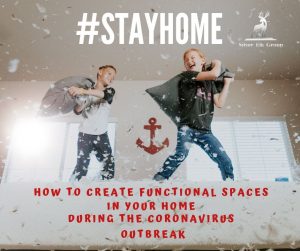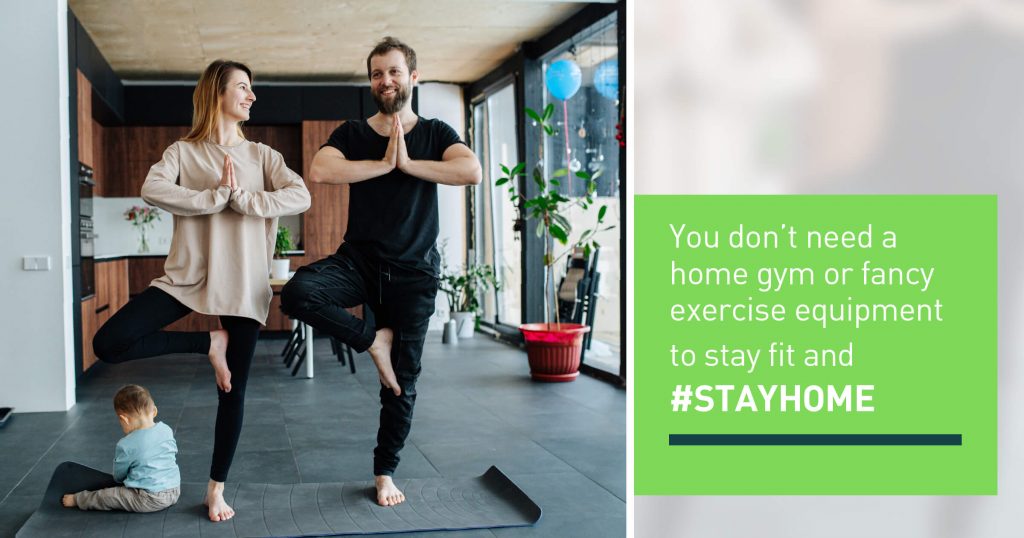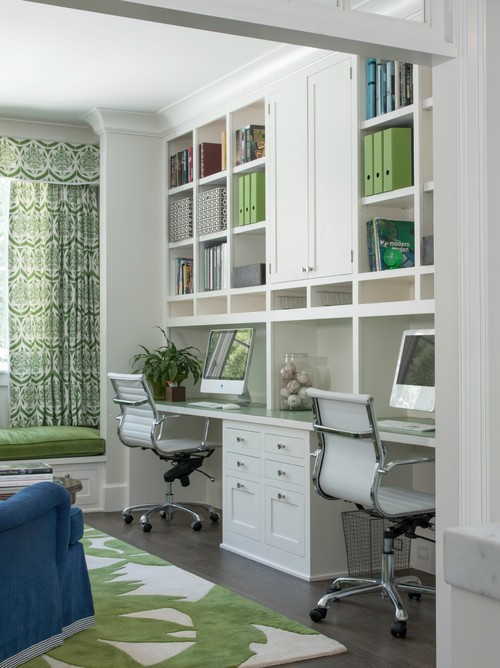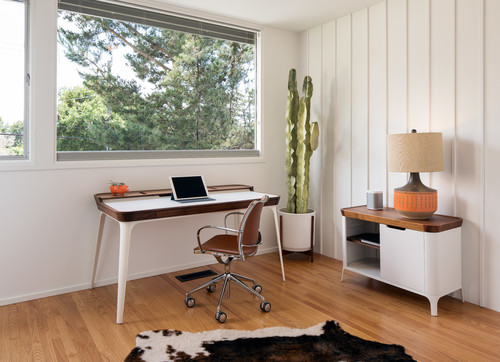Since the outbreak of the novel coronavirus (COVID-19), many of us are spending a lot more time at home. We’re all being called upon to avoid public spaces and practice social distancing to help slow the spread of this infectious disease. While it can be understandably challenging, there are ways you can modify your home and your lifestyle to make the best of this difficult situation.
Here are a few tips for creating comfortable and functional spaces within your home for work, school, and fitness. We also share some of our favorite ways to stay connected as a community, because we’re all in this together … and no one should face these trying times alone.
Begin with the Basics
A basic home emergency preparedness kit is a great addition to any home, even under normal circumstances. It should include items like water, non-perishable food, a flashlight, first aid kit, and other essentials you would need should you temporarily lose access to food, water, or electricity.
Fortunately, authorities don’t anticipate any serious interruptions to utilities or the food supply during this outbreak. However, it may be a good time to start gathering your emergency basics in a designated location, so you’ll be prepared now-—and in the future—should your family ever need them.
Ready to start building an emergency kit for your home?
Contact us for a free copy of our Home Emergency Preparation Checklist!
Working From Home
Many employees are being asked to work remotely. If you’re transitioning to a home office for the first time, it’s important to create a designated space for work … so it doesn’t creep into your home life, and vice versa. If you live in a small condominium or apartment, this may feel impossible. But try to find a quiet corner where you can set up a desk and comfortable chair. The simple act of separating your home and work spaces can help you focus during work hours and “turn off” at the end of the day.
Of course, if you have children who are home with you all day (given many schools and daycares are now closed), separating your home and work life will be more difficult. Unless you have a partner who can serve as the primary caregiver, you will need to help manage the needs of your children while juggling work and virtual meetings. Keeping a regular schedule will help you find your sanity! Don’t know where to start? If you have school age children ask them to help you design “the ideal day”. Then share yours.
If both parents are working from home, try alternating shifts, so you each have a designated time to work and to parent. If that’s not an option, experts recommend creating a schedule for your children, so they know when you’re available to play, and when you need to work.1 A red stop sign on the door can help remind them when you shouldn’t be disturbed. And for young children, blocking off a specific time each day for them to nap or have independent screen time can give you a window to schedule conference calls or work uninterrupted.
Don’t forget to take breaks from the screens and we cannot emphasize enough: while comfort is king, ergonomics is health. Click here for a short Video on ERGONOMICS AT WORK. Your back, neck and wrists will thank us later. As a former H.R. Executive that’s the best tip I can give you. We can’t do your work for you, but we can help you be productive.
Be well and keep scrolling for DESIGN TIPS to make your space more inviting.
 Homeschooling Your Children
Homeschooling Your Children
Many parents with school-aged children will be taking on a new challenge: homeschooling. Similar to a home office, designating a space for learning activities can help your child transition between play and school. If you’re working from home, the homeschooling area would ideally be located near your workspace, so you can offer assistance and answer questions, as needed.
If possible, dedicate a desk or table where your child’s work can be spread out—and left out when they break for meals and snacks. Position supplies and materials nearby so they are independently accessible, and place a trash can and recycling bin within reach for easy cleanup. A washable, plastic tablecloth can help transition an academic space into an arts and crafts area.
If the weather is nice, try studying outside! A porch swing is a perfect spot for reading, and gardening in the backyard is a great addition to any science curriculum.
In addition to creating an academic learning environment, find age-appropriate opportunities for your children to help with household chores and meal preparation. Homeschooling advocates emphasize the importance of developing life skills alongside academic ones.2 And with more meals and activities taking place at home, there will be ample opportunity for every family member to pitch in and help.
Remember, they are used to routines. If you can arrange some structure for them, albeit probably not without some fuss, the predictability of “what’s next” will help create some emotional security… for all of you.
I was talking to my sister, a mom of with multiples and she was trying to do it all, be it all and felt responsible for everyone’s happiness. Then she remembered she wasn’t alone. (See Socializing below). The Grandparents took a virtual shift (video show and tell or story time) and the teens were given choices on extra household “chores”. The game closet has never been this organized! And the laundry is magically reappearing clean in each bedroom. Giving teens a choice, even if they don’t like any of them, gives them a voice. Tis the season to ask more questions with this age, like a coach vs a parent. Good luck!

Staying Fit
With gyms closed and team sports canceled, it can be tempting to sit on the sofa and binge Netflix. However, maintaining the physical health and mental wellness of you and your family is crucial right now. Implementing a regular exercise routine at home can help with both.
If you live in a community where you can safely exercise outdoors while maintaining the recommended distance between you and other residents, try to get out as much as possible. If the weather is nice, go for family walks, jogs, or bike rides. Try TrailLink.com and check out what’s available near you, or for days off within your county or city shelter-in-place guidelines.
Can’t get outside? Fortunately, you don’t need a home gym or fancy exercise equipment to stay fit. Look for a suitable space in your home, garage, or basement where you can comfortably move—you’ll probably need at least a 6’ x 6’ area for each person. Many cardio and strength training exercises require little (or no) equipment, including jumping jacks, lunges, and pushups.
And if you prefer a guided workout, search for free exercise videos on YouTube—there are even options specifically geared towards kids—or try one of the many fitness apps available.
Socializing From a Distance
Even though we’re all being called upon to practice “social distancing” right now, there are still ways to stay safely connected to our communities and our extended families. Picking up the phone is a great place to start. Make an effort to reach out to neighbors and loved ones who live alone and may be feeling particularly isolated right now. Knowing you belong is a basic core need. Reach out especially to those you know that are single, or live alone. I can testify after “retrieving” my father from paradise after living alone in Tahoe, CA after retirement: It doesn’t matter if someone is in the most wonderful place on earth. Mankind was not created to live isolated or alone and connection is vital for mental health.
And while parties and playdates may be prohibited, modern technology offers countless ways to organize networked gatherings with family and friends. Try using group video conferencing tools like Google Hangouts and Zoom to facilitate a virtual happy hour or book club. Host a Netflix Party to watch (and chat about) movies with friends. Or plan a virtual game night and challenge your pals to a round of Psych or Yahtzee.
There are safe ways to connect offline, too. Rediscover the lost art of letter writing. Drop off groceries on an elderly neighbor’s porch. Or organize a neighborhood “chalk walk,” where children use sidewalk chalk to decorate their driveways and then head out for a stroll to view their friends’ artwork.
Of course, there’s one group of people who you can still socialize with freely—those who reside in your home. Family dinners are back, siblings are reconnecting, and many of us have been given the gift of time, with commutes, activities, and obligations eliminated. In fact, some families are finding that this crisis has brought them closer than ever. Did you know that Facebook has a video chat for multiple parties? Check it out. Use the phone call icon in Messenger to phone a friend, then swipe UP to add another. It’s like the Brady Bunch!
Now, for that office space: Here are some ideas to make your space more inviting
Layer in lights. Minimize the strain on your eyes when you’re staring at computer monitors all day. Heed advice from the American Optometric Association, which advises workers to direct light away from their line of sight. For example, the home remodeling website Houzz suggests layers of light may be best for a home office. Use a desk lamp to shine down on paperwork, have an overhead light, and use natural light from windows if you can.
Also, consider using a mirror to bounce light around the room—particularly if there are no windows.
Create a calming view. Consider positioning your desk so you can look out a window and enjoy the natural landscape.
Add comfy seating. Of course, you want your desk chair to look stylish, but don’t sacrifice comfort here. Look for an upholstered chair. Consider adding extra chairs to your space, too.
Add a plant. Plants around your desk can help improve air quality by reducing airborne dust levels. Plants also are known to help improve moods.
Or dress up the space with colorful flowers on your desk.
Use an adjustable desk. It’s never good to sit for hours on end. Consider an adjustable desk to get you on your feet. Desks that adjust so you can sit or stand are a hot trend in office spaces. Other ergonomic accessories also are popular, such as flexible footrests and adjustable keyboard platforms with padded wrist rests.
Bring in pops of color. Freshen up the paint color, or bring in colorful accents like curtains, artwork, or bright office supplies.
Most importantly: YOU ARE NOT ALONE
Even with all of the tools and technology available to keep us connected, many of us are still feeling stressed, scared, and isolated. However, you can rest assured that you are not alone. We’re not only here to help you buy and sell real estate. We want to be a resource to our clients and community through good times and bad. If you and your family are in need of assistance, please reach out and let us know how we can help. Our community connections run deep and your “need” may be the very answer to prayer for the small business owners or furloughed talent we can arrange to bless you both.
We’re here for you.
Kemberly & Gorden
#BuildingRelationships #GuidingYouHome #InvestingInDreams
www.SilverElkRealty.com
Sources:
- CNBC –
https://www.cnbc.com/2020/03/16/how-to-work-from-home-with-your-kids-during-the-coronavirus-outbreak.html - TheHomeSchoolMom.com –
https://www.thehomeschoolmom.com/benefits-of-homeschooling-2/ - National Association of Realtors.com –
https://www.nar.realtor/blogs/styled-staged-sold/sheltering-in-place-keep-your-business-humming-with-the-perfect-home-office

and change management is an art. We are fully dedicated to serving our clients before, during and especially after each purchase & sale. Gorden is our lead agent & master negotiator. Kemberly sets up private tours, coordinates staging, marketing & client care programs.Our SILVER STAR experience includes: Genuine Care, Effective Communication, Exceptional Education, and 100% Commitment to Your Goals.
Feel free to visit our company page www.SilverElkRealty.com to learn more about us and read our reviews.
We would love to meet you & support you with a strategic plan to Guide YOU Home.





